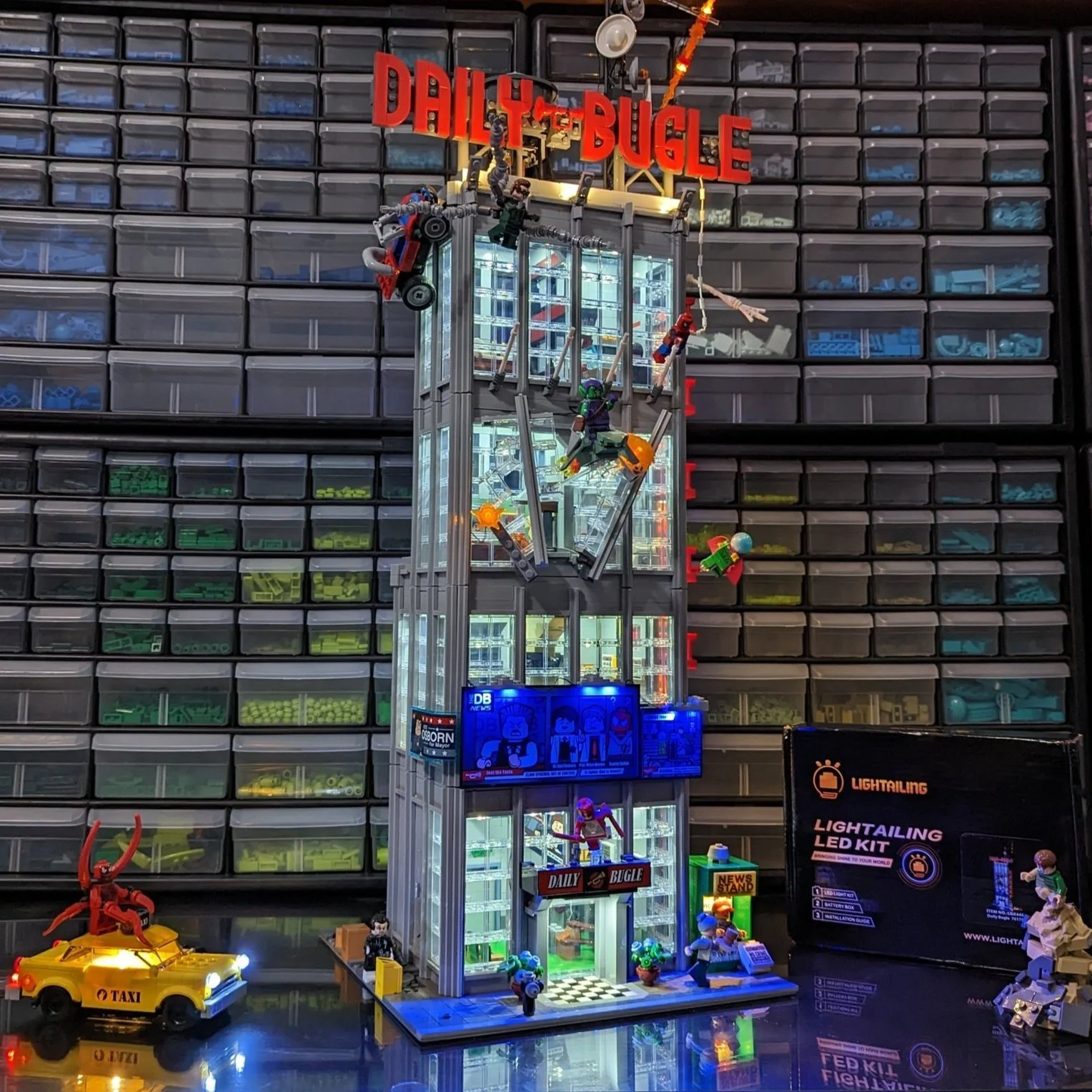Instructions, Please! How to Ask for LEGO MOC Instructions
/Guest contributor Joe Meno talks about LEGO instructions, if you should ask a MOC builder for them, and his experience in LEGO building that spans two millennia. (How’s that for a lead-in!?)
In The Beginning
You know, I’ve never asked for instructions for someone’s creation. Let me explain myself:
I started LEGO building way, way back in 1999 (yeah, the 20th century). At that time, the community was beginning to gather online, post on LUGNET, and post photos of their MOCs on Brickshelf. Digital modeling was just beginning with LDraw and MLCAD. It was a pretty bare frontier then, but there were LUGNET pages that were hopping with activity.
I saw some phenomenal builders (and later met them) and their works. But I wasn’t one to ask for instructions. If I saw a MOC that caught my attention, I would look at the photos and see if I could figure out how they were built. Reverse engineering a MOC from a photo was a challenge but should be possible.
I sucked when I started. Seeing models from the likes of Chris Giddens, Adrian Drake, and the rest of the Space gang was initially intimidating, and I wasn’t very successful in following what they built online. So, I went in my own direction. I built my own MOCs and, in a few years, was able to “hold my own”— I say that with air quotes because building is not a competition. Building is an exploration. It’s an exploration of my creativity.
When I see a MOC, it’s like visiting a city for the first time—and asking for instructions is a lot like asking for GPS directions. Sure, you’ll get to your destination, but building LEGO is not just about the resulting creation but the process leading up to the completed model. The GPS didn’t tell you about the things you’ll find on the way—maybe restaurants and shopping. GPS will also not tell you about the beautiful sunset on the way. It is something you have to notice as you go the same way that you learn techniques and take creative risks as you build something new and meaningful to you.
The Mother Of Invention
I started learning how to make instructions by necessity—I wanted them in BrickJournal. By that time, there was an app that I could use on my Mac to make digital models and another to make instructions. My building skills also got strong enough to figure out many of the models that made it into the magazine from the photographs sent to me.
In fact, I created one model I couldn’t possibly have asked for instructions. In 2012, I was at San Diego Comic-Con (thanks to my publisher, I was able to do presentations there) and saw futurist Syd Mead at a signing event. Because the signing was across the street from the Convention Center, there was a short line when I got there. I took my place and was genuinely starstruck meeting him—Syd Mead is a designer who has done work for TRON (the first one), 2010: The Year We Make Contact, and most notably, Blade Runner). I got my signed print, and went out… and then went back in.
Syd Mead showing his Spinner model
I had just remembered that he did a presentation for LEGO and was presented a model of the Bladerunner Spinner done in Technic. With that, I had a hook to request an interview… and I got it! After some planning, I went with a friend to Syd’s studio and did the interview.
The conversation was wonderful, and I did not ask for instructions for the Spinner. But I took a lot of photos, and when I got back home, I started to make a digital model to do a render. I had to learn how to do flex tube and add decals to parts (the decals crashed the app, so I had to send it to another person to render). In certain areas, I had to look really hard to deduce the parts that were used. But I managed to do it, and use a render for the magazine. And I learned a lot about digital building.
Digital building became a nice skill to have, as I discovered that I was building MOCs that were getting more and more complex. I started building digital models to archive my MOCs and also provide a repair document if I dropped or damaged them. For a small MOC, this may not be a big deal, but with some of my better MOCs, a digital version can be a lifesaver.
Breaking It Down
Another MOC I did was an office with an animation desk. This time I didn’t break it down digitally, but I did make a digital version. I just didn’t create instructions. In the digital file, there are no steps to complete these. It’s. One. Step. And since there are over 1,000 parts, that’s a big step! In this case, I know enough about my MOC to figure out what to do, I just need reminders of where pieces go.
My animation desk MOC
On the other hand, making instructions for a model is a different challenge from building it initially. To make instructions, a builder has to be able to break down their MOC such that it can be built with a minimum of difficulty. Some sections may have to be subassemblies that are built before they are added to the main model, so they have to be separated out.
LEGO instructions are generally built from the bottom (stacked) up, from back to front. A builder has to figure this out and when the model has to be turned for hidden parts. Making instructions is not easy to do, and it’s harder to do if the builder tries to make instructions from a completed model.
Starting Digitally
Digital models are not easy to create either. Software like LDraw and Stud.io have certainly lower the barrier of entry, but it is still a skill.
My Wall-e, which won an award at BrickWorld
For example, I built a MOC of WALL-E in 2008 that was motorized. It was a fun project to build, but since I was going to take it to events, I needed to make a digital model for reference. Digitally building this MOC, I learned, is not easy. Especially when there are over 1,200 parts in the model. After all is said and done, breaking down the model digitally took me 55 steps, not including 200 more steps for subassemblies to make coherent instructions.
Many builders now start their building digitally—Stud.io has made it easy to do. However, it’s a little silly to expect a builder to have instructions to a MOC, unless they want to sell them.
LEGO builders generally don’t build to make instructions—they build to explore. They have their own destinations to go to, but they are happy to see what else is out there. Don’t be put off by those builders who choose to sell instructions either—it takes time and thought to make clear instructions for others to build.
He also went to Disneyland!
How to Ask for Instructions
Ultimately, there are many pros and cons to making instructions for MOCs. You could share a model, techniques, and the joy of building. You might be able to make a little bit of money. Or you can archive your builds digitally. But instruction making is hard and takes time. It could lead to MOC theft or, worse, a knock-off company stealing and producing the design altogether.
What is the worst, though, is when an adoring public feels entitled to instructions just because they are so prevalent. (If you have doubts, check the comments on the Snow White cottage MOC that BrickNerd posted a little while back.) Instructions are an art form that LEGO has about perfected. It is one of the key things that set their products apart from their competitors, so expecting LEGO fans and MOC builders to have that same level of dedication, time commitment, and expertise is not feasible.
So how do you respectfully show your enthusiasm about recreating a MOC you see online? Well, if you see something online that you want to build, don’t demand instructions. Instead, ask for building photos or for more detailed WIP shots (work in progress). Show the effort you are putting into the interaction by looking at the MOC, thinking about how it may be built, and then asking specific questions about a mysterious piece or technique. There’s nothing wrong with asking for something the builder may already have or can make in a few minutes—especially something that may lead toward a relationship of respect between builders.
If you follow this approach, you’ll probably get a better response than just “no.” If you show your genuine interest in the building skill behind the model as opposed to the model itself, you give some encouragement to the builder, which is always appreciated. And you just might make a friend in the process.
Just remember that it's the journey, not the destination, that matters in building LEGO MOCs. By trying to figure out a build, you could find something completely new to show to all of us in your next LEGO creation!
Best of BrickNerd - Article originally published June 20, 2024.
Have you ever asked for instructions? Did you regret the response? Let us know in the comments!
Do you want to help BrickNerd continue publishing articles like this one? Become a top patron like Charlie Stephens, Marc & Liz Puleo, Paige Mueller, Rob Klingberg from Brickstuff, John & Joshua Hanlon from Beyond the Brick, Megan Lum, Andy Price, Lukas Kurth from StoneWars, Wayne Tyler, Monica Innis, Dan Church, and Roxanne Baxter to show your support, get early access, exclusive swag and more.






























